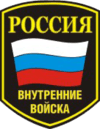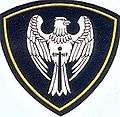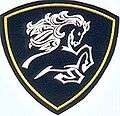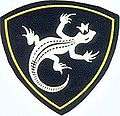Internal Troops of Russia
| Internal Troops of the Ministry of Internal Affairs of the Russian Federation Внутренние войска Министерства внутренних дел Vnutrenniye Voiska Ministerstva Vnutrennikh Del | |||||||
|---|---|---|---|---|---|---|---|
| Common name | Internal Troops | ||||||
|
Emblem of Ministry of Internal Affairs and Internal Troops of Russia[1] | |||||||
|
Flag of Internal Troops: a 2:3 white flag with rose madder cross pattée and emblem of Internal Troops in the center of it[2] | |||||||
| Agency overview | |||||||
| Formed | March 27, 1811 | ||||||
| Dissolved | April 5, 2016 | ||||||
| Superseding agency | National Guard | ||||||
| Employees | 182,000 in 2012[3] | ||||||
| Legal personality | Governmental: Government agency | ||||||
| Jurisdictional structure | |||||||
| Federal agency | Russia | ||||||
| Governing body | Ministry of Internal Affairs (Russia) | ||||||
| General nature | |||||||
| Operational structure | |||||||
| Headquarters | Moscow | ||||||
| |||||||
The Internal Troops of the Ministry for Internal Affairs of the Russian Federation (MVD RF) (Russian: Внутренние войска Министерства внутренних дел, Vnutrenniye Voiska Ministerstva Vnutrennikh Del; abbreviated ВВ, VV), was a gendarmerie-like paramilitary force of the federal government in Russia. On April 5, 2016 it was officially split from the Ministry of Internal Affairs to form the basis of the National Guard of Russia.
Internal Troops supported and reinforced the Politsiya, deal with large-scale riots, internal armed conflicts and safeguarding of highly-important facilities (like nuclear power plants). As such, the service was involved in all conflicts and violent disturbances in modern Russia, including and First and Second Chechen Wars. Internal Troops fell under Armed Forces military command during wartime and fulfill the missions of local defence and rear area security.
Internal Troops consisted of both volunteers and conscripts and hence the number of active service members keeps fluctuating. On the moment of their disestablishment, it had less than 200,000 active members and had had shortage of officers since 1998. Its strength plunged to this level from the peak strength of 350,000 active members. The commander of the Russian Internal Troops was Colonel General Viktor Zolotov until their disestablishment occurred in April 2016.
History

Internal Troops in the USSR
The modern Internal Troops were raised by the All-Russian Central Execuitive Committee as part of the NKVD in 1918, and was reorganized in 1919 unto the Internal Security Forces (Voyska vnutrenney okhrany Respubliki,VOHR). In 1919, these were transferred to the Cheka and in 1922-23 into the OGPU.
On 28 July 1988, the Presidium of the Supreme Soviet issued a decree “On duties and rights of the Internal Troops of the USSR MVD when safeguarding public order”, clarifying its role in the cracking USSR.[4] However, the Internal Troops were still a part of the Soviet Armed Forces and this state of affairs pleased no one. The Armed Forces did not want to be seen as a force of internal suppression, especially after the disastrous Afghan War. The MVD was finding itself having to extinguish increasingly frequent and violent hot spots and to cope with growing and increasingly well organised and equipped criminals. For this the MVD needed more fire power. On 21 March 1989, the Presidium decided to take the Internal Troops out of the Armed Forces and the Ministry of Defense[5] and give them to the Internal Affairs Ministry.
In 1990, the establishment of the RSFSR MVD meant that the Internal Troops in the SFSR were now subordinated to the republican ministry.
With the April 2016 foundation of the National Guard, the IT became the National Guard Forces (Войска национальной гвардии, Voyska Natsionalnoy Gvardi) and now reports directly to the Security Council and its chairman, the President of Russia, and thus removed from the MVD proper.
Legal basis
_(494-20).jpg)
The Federal Law No.27-173 was signed into law on 6 February 1997. The law set the operational standards for the Internal Troops of the Russian Federation. The law is entitled "On the Russian Federation Ministry of Internal Affairs Internal Troops".[6] When supporting a state-of-emergency regime, Internal Troops were paid salary increases and additional monetary payments according to federal laws and other legal acts approved by the Minister of Internal Affairs. Article 38 granted senior operational commanders the right to call in subunits of special motorized formations and military units outside their deployment areas for a period of up to one month.
The federal law also detailed the important role that the Russian Ministry of Defense played in the affairs of the MVD's Internal Troops when crises arose. For example, MOD was responsible for providing airliners for supporting Internal Troop activities during emergency situations, and conditions of armed conflicts; carrying out the stockpiling and echelon armaments and military equipment, ammunition, fuel and supplies for the mobilization deployment of the Internal Troops in wartime; and transferring arms and military equipment free of charge to the Internal Troops through support services based on special decisions of the federal government, and rendering assistance in the repair and restoration of damaged arms and military equipment.
General organisation
.jpg)
Despite being subordinated to civilian MVD authority, Internal Troops were a paramilitary force with centralized system of ranks, command and service. The Chief Commander and Staff of the troops reported only to Ministry of Internal Affairs, maintaining their separate chain of command. The Chief Commander was concurrently First Deputy Minister of Internal Affairs. VV units in Soviet Union were predominantly formed up of conscripts drafted by the same system as for the Soviet Army. Modern Internal Troops in Russia, as and in Ukraine, experienced a slow transition to the contract personnel system. VV officers were trained in both own special academies and Army's military academies.
The main kinds of Internal Troops were field units, various facility-guarding units, special motorized units, riot control and patrol units, and special forces like Rus. Since the 1980s, spetsnaz units were created within the VV to deal with terrorism and hostage crises. Fields units were essentially light motorized infantry, similar to respective regular army units by their organization and weapons. They and the special forces have been heavily engaged in the armed conflicts in Chechnya and the broader North Caucasus.
Districts and formations
.jpg)
The organization of the Russian Internal Troops comprised headquarters, military units, military training institutions and the institutions for Internal Troops activities, and maintenance and administration bodies. The largest units were located in all major cities.[7]
Internal Troops districts:
- Northwestern District
- Moscow Orshansko-Hingansky Order of the Red Banner District
- North Caucasus District
- Privolzhsky District
- Ural District
- Siberian District
- Eastern District
Military units under direct subordination:
- A separate rapid deployment division (ODON). This formation, also known as the Dzerzhinsky Division and based near Moscow, was the most well-known formation of the Internal Troops.
- The Central Communications
- Engineering Center
- Intelligence Directorate Internal Troops under the Intelligence Chief-Deputy Chief of Staff of the Internal Troops.
Missions
.jpg)
- Security – to guard "key" state institutions (except for the Kremlin and the highest echelons of the government which are guarded by the Federal Protective Service (FSO)), nuclear facilities, special storage depots and military bases.
- National defence – to conduct rear area security operations and all military operations within national borders, counter-intelligence authority in wartime.
- Prisoner transport – in Soviet times, also guarded and operated the Gulag camps. Today: convict convoyage and transport. Security and operation of prisons have been performed by the Federal Penitentiary Service since its creation in 1994.
- Public order – to assist the Russian Police for riot control operations when OMON units are not available.
- Border control – to assist the Russian Federal Border Service in the protection of the State border of the Russian Federation.
- Military police functions.
- Counter-terrorist operations (VV special forces units such as Vityaz and Rus).
- Possible counterweight to the regular military, especially during the Soviet era.
Equipment

Internal Troops' equipment included:
Transportation
Weaponry
Shoulder patches
 |
.png) |
 |
 |
 |
 |
 |
 |
 |
 |
 |
 |
 |
See also
References
![]() This article incorporates public domain material from the Library of Congress Country Studies website http://lcweb2.loc.gov/frd/cs/.
This article incorporates public domain material from the Library of Congress Country Studies website http://lcweb2.loc.gov/frd/cs/.
- ↑ "Указ Президента Российской Федерации от 10.11.1998 г. № 1333 "Об учреждении геральдического знака — эмблемы органов внутренних дел Российской Федерации и внутренних войск Министерства внутренних дел Российской Федерации"". Kremlin.ru. Retrieved April 9, 2016.
- ↑ "Указ Президента Российской Федерации от 31.12.2015 г. № 687 "Об учреждении флага внутренних войск Министерства внутренних дел Российской Федерации"" (PDF) (in Russian). Kremlin.ru. Retrieved April 10, 2016.
- ↑ Национальная гвардия Владимира Путина — На базе подразделений МЧС, Внутренних войск, ВДВ и военной полиции может появиться новая силовая структураArchived July 2, 2012, at the Wayback Machine.
- ↑ Organy I Voyska MVD Rossiiy, MVD Moskva 1996, p461.
- ↑ Organy I Voyska MVD Rossiiy, MVD Moskva 1996, p.332
- ↑ 'Rossiiskaya Federatsiya Federal'ni Zakon o vnutrennikh voiskakh Ministerstva vnutrennikh del Rossiiskoi Federatsii' of 25 December 1996.
- ↑ Neil Baumgardner, Russian Armed Forces Order of Battle, see bottom of page.
Further reading
- Galeotti, Mark. "Russia's Interior Troops on the rise." Jane's Intelligence Review 9 (1997): 243-246.
External links
- Russian Internal Troops official website (Russian)
| Wikimedia Commons has media related to Internal Troops of Russia. |



